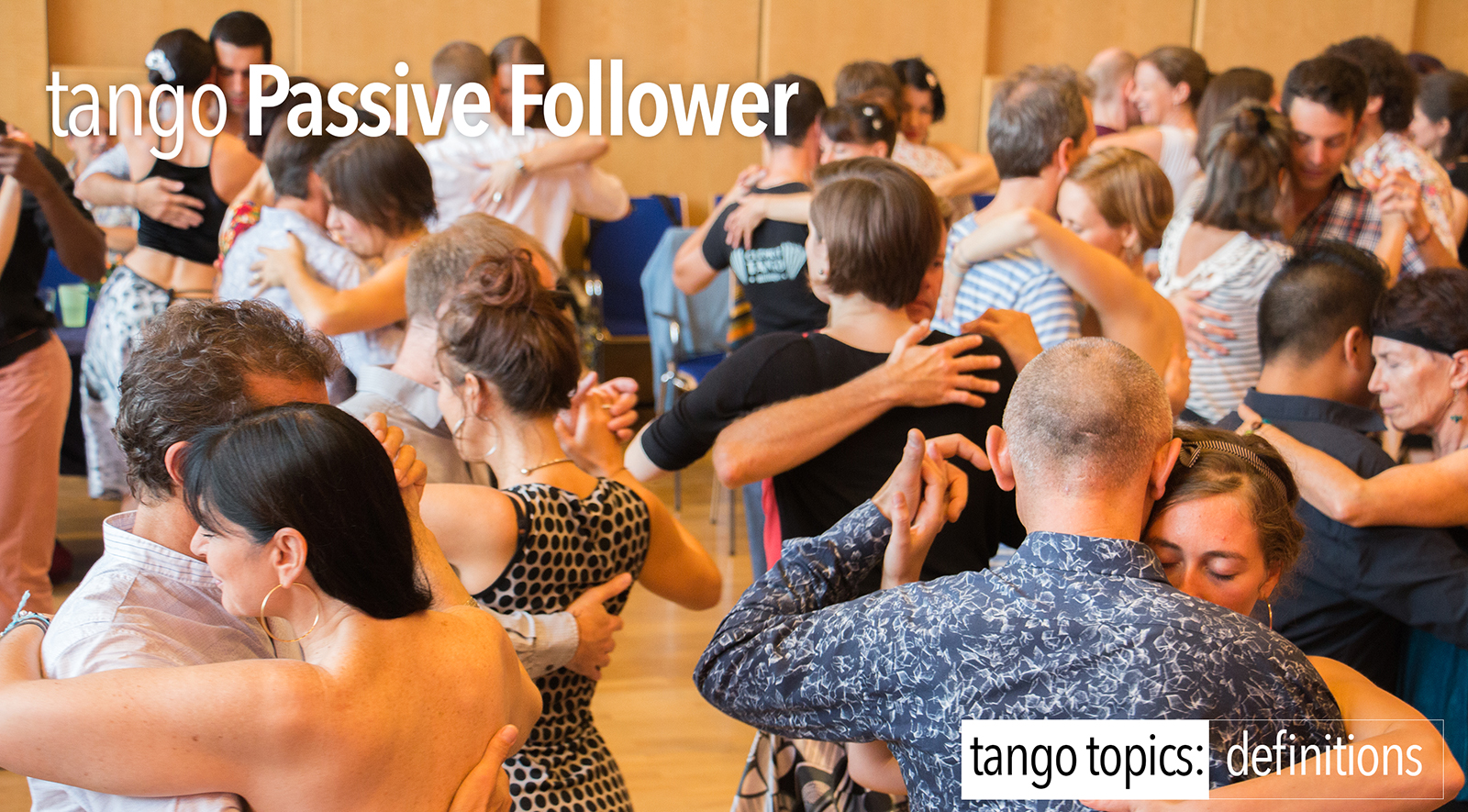The Passive Follower. From time to time, you’ll hear the opposite of this phrase, ‘The Active Follower’. While there is a definition of this term here. It is important to recognize that there are 4 other types of Followers, and in specific the opposite of the ‘Active’ Follower, and that would be ‘The Passive Follower’. It’s important that we define the ‘Passive’ Follower for a variety of reasons, most notably because it is a very necessary stepping stone towards becoming an Active Follower.
The role of the Passive Follower does not add, or subtract from what was led, nor do they interpret what was led, nor imbue, distort, or try to control, but rather they’re all about listening to what was led, and following exactly that and nothing more than that.
Truth be told you can not become an Active Follower (the next stage up) without passing through the ranks of being a Passive Follower first! You don’t immediately get to proclaim that you’re an Active Follower without first understanding what it is that you’re being active about, hence ‘The Passive Follower’!
Usage. Typically this phrase is used to describe a less than desirable Follower, when in reality the Passive Follower is a way of describing a noble state of Following and really what happens most of the time in the role of the Follower. In reality this type of Follower is all about listening, really feeling what was led. It’s about creating the neurological relationship between what is felt/‘heard’ and the activity intended. While at the same time, and this part is very important, not inferring what was intended but Following exactly what was led in exacting detail. If they feel ‘X’, they do ‘X’. If they feel ‘Y’, they do ‘Y’. There’s no middle ground of ‘hmmmm what was that ?’. The Passive Follower is all about the honesty and integrity of Following.
Truthfully there are whole swaths of Followers that subscribe to this way of dancing, that this is the only idea of dancing, and there can be no greater call than to be ‘Passive’ in their Following. In reality they’ve been indoctrinated into being a Passive Follower from the first moment they start classes or dancing. How’s that ? They’re told to “wait for the lead”. As a direct result of this ‘waiting’, there is often ‘lag’ in the execution of their dancing abilities. ‘Lag’ in the respect that there is noticeable, discernible, palpable, and definitive hesitation in not just the execution of what was led, but deliberate ‘heaviness’ or seeming ‘grounded’ behavior. This thereby creates a necessity (for some leads that dance with these type of Followers), a clear desire, to engage in actual physiological force to ‘push’ their Followers to do X, Y, and Z. To Squeeze, compress, and then pull them into X, Y, and Z. Usually what goes hand-in-hand with this type of Follower is also a clear desire to rely on ‘resistance’ based dancing techniques.
In reality they’ve been told to ‘wait’ so often that resistance and lag becomes 2nd nature to them and they don’t even realize that they’re doing it at that point. And as a result of that ‘wait’ being drilled into them by every single teacher (male and/or female), and every Lead they dance with, the ‘lag’ becomes their way of dancing. While this may sound bad, it is only a stage towards becoming a better dancer, a more responsive dancer (which by the way is not an Active Follower).
At the same time, there are a healthy dose of Leads that see the role of the Follower is Passive. Following exactly what they led, and don’t even think of adding anything to it! That includes, adornments, embellishments (not the same things by the way), or god forbid becoming ‘Active’.
Something you should also pay attention to here is that usually, the role of the Passive Follower is also equated with less than desirable technique, and sloppy and or poor execution. And that’s not necessarily the case. The role of the Passive Follower is also one of learning to create better execution and desirable technique!
At some point along the curve of this state of passivity, a transition sometimes (operative word) occurs that invokes the idea of ‘getting there’. “Getting there” ???? What does THAT mean ? It means employing or using alacrity, stability, clarity in one’s execution of the three primary steps of the dance: Forward, Side, and Back. It means quickly getting from an open state, to a closed state (Collection). It means executing with speed, and more importantly diligence! Or what Tango Topics refers to as “MYA” or “IMM”. ‘Move Your Ass’ or ‘I Move Me’. Meaning ? That they get the hint that moving as though their feet were stuck in quicksand, and their leads pushing them here and there, that perhaps this may not necessarily be a desirable state. So instead they get wise to the idea of MYA, but at the same time employing acute listening skills! Remember the state of the Passive Follower is LISTENING! Again, this is not an Active Follower. This is a necessary and needed progression towards the role of the Active Follower.
Lead, Follow, or Both ? Follower Only.
The Tango Topics Opinion: As indicated above, there are 5 types of Followers. 1.) Passive. 2.) Active. 3.) Delightful. 4.) Willful. and 5.) Wild. The last two you honesty want nothing to do with, unless you want to discourage dancing with someone ever again. The last 2 have their benefits in that if you go ‘rogue’, then you can pretty much guarantee that you won’t be dancing with ‘A’ ever again. And that may be your master plan, it’s most certainly one way to discourage ‘A’ or anyone like ‘A’ from ever dancing with you again. However, barring that, ideally we’re wanting to start out in earnest as a “Passive” Follower.
The primary goal of this noble state is to learning to listen, and ‘listen’ in this case is really about feeling a particular motion in its execution that you can begin to clearly identify X from Y, a walk from a milonguero ocho, a traveling ocho from a circular ocho, the follower’s molinete from a milonguero turn (there’s no applied disassociation in one of them), and of course an Argentine Cross from an Ocho Cortado. While you may not know the names of these things and you don’t need to necessarily, you can and should at the very least be able to discern one from the other, and then learn to execute them with all due haste, diligence, and with extreme prejudice! Further still the Passive Follower is doesn’t just hear/feel one specific idea for a particular piece of vocabulary, but all of them! In as many different ways possible. The more versatile you are in this, the better you will be able to transition into the role of the Active Follower and ultimately the Delightful Follower.
You would think or believe that your end goal is the role of the Active Follower, and that’s not the case here. You’re really shooting for the Delightful Follower. The Passive Follower is the first step on this pathway. It’s all about developing the necessary skill set to weed out individual ideas, individual bias, to learn to feel/hear/listen what was led, and then to learn to associate what was led with what needs to be done. While at the same time, learning to execute with exacting detail, precision, with speed and/or alacrity, all the while learning above all else to control one’s own body in this process. All the while not interjecting or creating supposition, but creating a near perfect state of tango honesty. You follow what was led and nothing more. This is the role of the Passive Follower.
Typically the role of the Passive Follower can take anywhere from 3 to 9 months to develop, assuming that certain conditions exist. Most notably that they have access to good, clean teaching resources that reinforce learning to Listen, learning to execute, and most of all learning to discern and differentiate one idea from the next. It can accentuate the learning process if the Follower has a good local role model to aspire towards that can show and detail certain techniques and ideas that aren’t generally talked about in classes and/or workshops. It also helps to have access to a cadre of Leads that span a spectrum of less than desirable to desirable and then towards delicious! Not to mention, but we will any way, a sincere desire to improve. If those conditions do not exist, then it may take somewhat longer (a lot longer) to develop into a good, but responsive, Passive Follower! A lot longer.
To be clear, a good number of Followers stop just prior to the Responsive Passive Follower stage, and some of them never realize that they have. They do, rightfully, give up for a variety of reasons. Not the least of which is that they have no further challenges, or so they believe. Still another common one is that the quality of the local Leads they’re dancing with, they’ve essentially reached the pinnacle of who they can dance with, and this does not include the dreaded Tango Baggage that can create a social barrier to their further advancement.
So that we’re absolutely opaque here, these statements are not ‘Follower Bashing’, nor is this disparaging of the role of the Follower in any way, shape, or form. Those of you who read this page frequently, know that the author has done extensive work in both roles and done so in heels and socially, read the bio in case you have doubts. These statements are active observations of the process of Following, after having taught and danced both roles for the last 10+ years, a wide range of Leads AND Followers and the necessary survival skills that they must develop in order to progress beyond these states.


